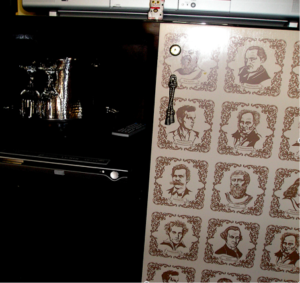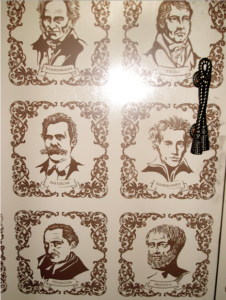After my last set of posts on hallway pitching, I thought I heard some frustrated sighing out there. Oh, you may have been too polite to post a question about it, disgruntled gusters, but I have marvelous powers of perception. Not to mention projection. I sensed your unspoken irk.
Don’t believe me? See if this question hasn’t been poking at the back of your mind lately: “But Anne, if the elevator speech is so effective at piquing interest, why SHOULDN’T I just use it as my pitch in my meetings with agents and editors? Why do I need to prepare more than one speech?”
The short answer: so you can be flexible.
As ever-perceptive reader Dave has been pointing out in his comments, a full-scale pitch is an interactive process, not a speech declaimed to an audience who can only clap or boo at the end. If an agent or editor likes your hallway or full pitch, she’s probably going to ask some questions.
Perhaps — and this comes as a substantial shock to most first-time pitchers — even DURING your pitch.
This is why I’ve spent the last month trying to nudge all of you away from the all-too-common notion of the three-line pitch, practiced over and over as if they were lines in a play. If you concentrate too much on the words themselves, and the short amount of time you have to say them, it’s too easy to freeze up when an unexpected question knocks you off script.
And yes, I know: precious few self-styled experts seem to teach pitching that way, but in my experience, helping people learn to talk about their work professionally and comfortably in a broad variety of contexts works far better in practice than ordering people to write, memorize, and blurt a specific number of lines of text.
Hey, I warned you up front that my views are a trifle iconoclastic. Call me wacky, but I’m not going to pass along a dogma to my readers unless I have good reason to believe it’s going to help ’em get published.
Admittedly, a lot of people do use the 3-sentence elevator speech as a pitch; to be fair, it can work, just as hallway pitches work. However, a 30-second pitch leaves quite a bit of a 10-minute appointment unused, doesn’t it? And why would you trade an opportunity to say MORE about your book for a format that forces you to say LESS?
Also, to revisit some issues from earlier in this series, by emphasizing the 3-sentence pitch to the exclusion of all others, I think the standard sources of writerly advice have left first-time pitchers ill-prepared to address those other vital issues involved in a good pitch, such as where the book will sit in Barnes & Noble, who the author thinks will read it, why the target market will find it compelling…
In short, all of the information contained in the magic first 100 words. And while it may seem a tad silly to have to practice saying your own name, or to remind yourself to mention that your book is a novel (or a memoir, or a nonfiction book) most people are NERVOUS when they pitch. Practice will help you remember to hit the important points.
You’d be amazed (at least I hope you would) at how many first-time pitchers come dashing into their scheduled pitch appointments, so fixated on blurting those pre-ordained three sentences that they forget to:
(a) introduce themselves to the agent or editor, like civilized beings,
(b) mention whether the book is fiction or nonfiction,
(c) indicate whether the book has a title, or
(d) all of the above.
I find this sad: these are intelligent people, for the most part, but their advance preparation has left them as tongue-tied and awkward as wallflowers at a junior high school dance.
We’ve all been there, right?
And don’t even get me started on the sweat-soaked silence that can ensue AFTER the 3-sentence pitcher has gasped it all out, incontinently, and has no more to say. In that dreadful lull, the agent sits there, blinking so slowly that the pitcher is tempted to take a surreptitious peek at his watch, to make sure that time actually is moving forward at a normal clip, or stick a pin in the agent, to double-check that she isn’t some sort of emotionless android with its battery pack on the fritz.
“And?” the automaton says impatiently. “Are you done?”
“What do you mean?” I hear some of you gasp, aghast. “Aren’t they going to do all the talking after I finish my pitch? Doesn’t the agent or editor make a snap decision about representation on the spot, and immediately either send me packing or leap into chatting with me about her plans for marketing my book?”
Well, not usually, no, and in fact, in recent years, as the elevator speech has come to be taught as the standard pitch, I have been noticing corresponding trend for agents and editors sitting around in that bar that’s never more than a hundred yards from any writers’ conference, complaining, “Why does everyone stop talking after a minute or so? I’m getting really tired of having to drag information out of these writers on a question-and-answer basis. What do they think this is, an interview? A quiz show?”
Call me unorthodox, but I don’t think this is a desirable outcome for you.
But that doesn’t mean that you should just prepare a hallway pitch and trust your luck to be able to handle questions about it for the rest of your pitch appointment. You will be happier in that meeting if you have prepared at least the outline of a 2-minute pitch.
And, by the way, you should time it as you say it out loud, to make sure it can be said in under two minutes without leaving you so breathless that oxygen will have to be administered immediately afterward.
Why? Well, even more common than pitchers who dry up after 45 seconds are writers who talk on and on about their books in their pitch meetings so long that the agent or editor hasn’t time to ask follow-up questions. You really do want to keep your pitch to roughly two minutes (as opposed to your hallway pitch, which should be approximately 30 seconds), so that you can discuss your work with the well-connected, well-informed industry insider in front of you.
A pitch meeting is a conversation, after all, not a stump speech: you WANT it to start a conversation, not to engender stony silence, right? Come prepared to talk about your work — and in terms that will make sense to everyone in the industry.
And just how to do that persuasively, my friends, is my topic for the rest of the week, in case you were wondering when I would stop telling you about the pitch and start showing you how to do it.
Trust me, you can do this. Keep up the good work!


